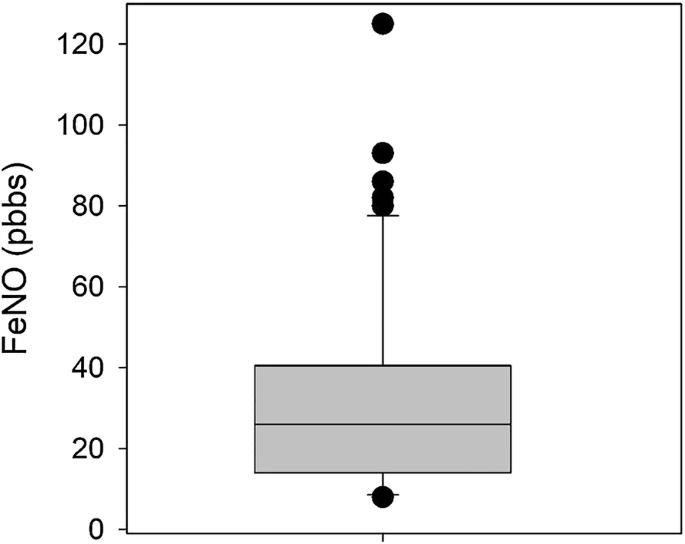- Research
- Open Access
Allergy, Asthma & Clinical Immunology
Abstract
Background
 |
| A box-plot of FeNO levels. The median is shown with 25–75th percentile. An outlier of 279 is included in the analysis but not shown |
The National Review of Asthma Deaths UK highlighted that 46% of deaths could be avoided and recommended that all sufferers receive a structured asthma annual review which assess asthma control. In primary care this is commonly achieved using symptom-based questionnaires such as the Asthma Control Test (ACT). A newer method of assessing asthma control is Fractional Exhaled Nitric Oxide (FeNO) testing, which is currently recommended for the diagnosis of asthma, but not for monitoring of asthma control.
The study aim was to assess the correlation between self-reported symptoms as measured by the ACT and FeNO testing and the subsequent impact of FeNO testing on prescribing of asthma medication.
Methods
A retrospective review of 65 patients who had received both ACT and FeNO testing as part of their asthma annual review. A spearman correlation was used to estimate the correlation between ACT scores and FENO levels. A χ2 test was used to compare prompting frequency of the measures and Kendalls τ statistic was made to estimate their concordance and influence on subsequent ICS medication prescription.
Results
The mean age of the participants was 41 years (4–93 years). There was no statistically significant correlation between ACT and FeNO (ρ = 0.195, p = 0.120). The median FeNO was 26 ppb (range 8–279 ppb), and the ACT score 20 (range 5 to 25 points). Furthermore, FeNO more frequently prompts a change in medication than ACT, 66% versus 42% (p = 0.005). A low concordance between the measures was found (Kendall’s τ statistic − 0.321).
Conclusion
FeNO should be considered for monitoring of control in asthma. To balance the cost of implementing this technology into primary care a risk stratified approach could be applied to testing.
No comments:
Post a Comment